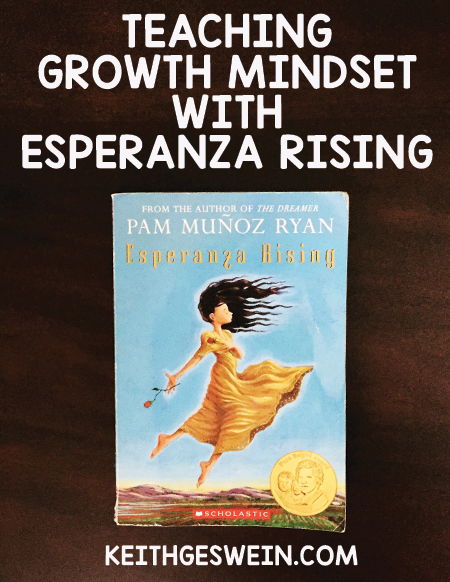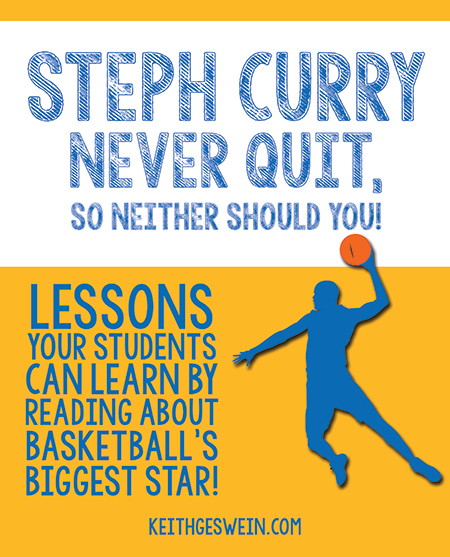Students can learn so much more from novels than test-prep passages. I know you’re under a ton of pressure to get students to pass multiple-choice reading tests. But I hope you will find time this year to read awesome novels, like Esperanza Rising. In addition to teaching reading skills, your students can learn to face challenging situations instead of giving up.

Esperanza Rising is a wonderful story of a young girl whose life changes dramatically after a terrible tragedy. The author, Pam Munoz Ryan, does a beautiful job of developing characters that students feel an immediate connection with. This can really help your students develop a growth mindset. I’ve taught so many students whose first instinct is to quit when faced with a challenging situation. I hope you teach your students that challenging school assignments can help them grow academically. Facing difficult situations in life can help them grow as a person. We all know students are far more likely to remember these ideas from characters they connect with during a story as opposed to us lecturing them. So here are three ways you can use the characters and events of Esperanza Rising to foster a growth mindset with your students.
1. You can learn a lot about yourself during difficult situations
Chapter one paints Esperanza as a nice, but spoiled, rich girl. Her father is a wealthy land-owner. Esperanza spends time with her father in the fields but never has to actually do any of the work. She has servants attending to her every need. She lives in a beautiful home and has very nice things. Esperanza has a wonderful, loving family. But that all changes when her father is murdered. Esperanza and her mother are forced to leave everything behind and flee to the United States.
Esperanza’s new home in California is tiny and dirty. She is thrust into a new life where she has to do many chores that servants had always done for her. Esperanza is miserable. Her father has just died. She is living in a strange place. She is going to have to work in a way that she’s never worked before. It would be really easy for Esperanza to quit.
Things get worse for Esperanza before they get better. One of her first chores is to sweep, and she fails because she’s never had to sweep before. Other girls laugh at Esperanza’s inability to perform such a simple task. She refuses to leave the house for a day because she is so humiliated. Later, she has to take care of babies. She feeds them plums, not knowing this would give the babies an upset stomach. She also burns food that she cooks. She has given these tasks an honest effort, but has failed. Again, it would be really easy for Esperanza to quit.
But Esperanza decides to ignore the taunts of others and continue cleaning. She continues looking after the babies. She continues cooking. Day, after day, after day. SLOWLY, Esperanza learns how to accomplish these tasks. I emphasize the word SLOWLY with my students to help them realize success does not happen overnight, as Esperanza finds out.
Later, Esperanza’s mother gets really sick. She has to stay in the hospital for several months. Now, Esperanza is forced to work in the fields. Esperanza promises her mom to take care of the family. I tell my students that Esperanza is probably not the best field worker, but she does well enough to keep her job and provide a little bit of money that her family needs to survive while her mother is sick.
The book ends one year after her father died. During that year, Esperanza has done things she never thought she could do. I have the students reread chapter one and think, “Would Esperanza have ever dreamed she could accomplish these things (cooking, cleaning, babysitting, farming, etc.) just a year earlier?”
Also, kids need to realize that there are times when life will be challenging. But it is possible to come out of these challenging situations a stronger person. Emphasize to your students that Esperanza went from a spoiled, helpless girl to a strong, determined woman who provided for her family – all in one year.
This is awesome for students who are adapting to a new school, city, or country. You can say:
“I know it’s hard adjusting to life in this new school/city/country. Remember Esperanza. She fought through lots of challenging situations and after a year, she started to feel better about her new home.”
2. Accept help
When Esperanza arrived in California, a young girl named Isabel greeted her. Isabel was in awe of Esperanza. Isabel had heard all about Esperanza’s extravagant life in Mexico before her father died. Esperanza, on the other hand, looked down on Isabel for being poor. Esperanza saw Isabel’s meager home and possessions. She wondered how Isabel could be so happy with so little.
SLOWLY, Esperanza realizes that Isabel is a kind girl. Esperanza also realizes that Isabel knows how to do things like clean and babysit. So Esperanza drops her ego and asks Isabel to teach her how to sweep and take care of babies, even though she thought Isabel was beneath her. Isabel is a huge help as Esperanza starts to learn how to tackle the day-to-day chores of her new life. Esperanza eventually becomes friends with Isabella.
This is an outstanding reminder to students that everyone needs to accept help. It’s also a good reminder that the people we look down upon may be the ones who can help us the most.
Tell a student:
“I know you’re struggling to learn this science vocabulary. And I know you’re not getting along with (insert name or names of students), but I think the two of you could help each other learn this vocabulary and do well on your quiz. Remember how Esperanza accepted help from Isabel. I think (name of student) could help you just like Isabel helped Esperanza.”
3. Remember the things you have to be thankful for
Esperanza hears her mother singing a few hours after they arrive at their new home in California. Esperanza is furious. How can her mother possibly be singing during such a terrible time? They have gone from living in luxury to living in poverty in a very short time. But Mama tells Esperanza to focus on what they do have. They have each other. They have a place to live. They have people there who can help them. And Mama has a job. Mama reminds Esperanza that Abuelita would want her to make the best of her new life instead of dwelling on all the negatives. Mama is not saying their new life is going to be easy. But she reminds her daughter they still have a lot to be thankful for.
In my 14 years of teaching, I’ve taught many kids who have a difficult time focusing on the positives. This story of Mama singing is great for students to think about during challenges they face. Students need to know that it’s ok to get discouraged during challenging times. Don’t tell students that they have to be positive, happy, cheerful people 24/7. But Mama’s attitude helps kids remember that it’s possible to find a little bit of joy even during the gloomiest of situations.
Tell a student:
“Sure you’re struggling with this math problem. It’s really hard and that’s no fun. But think about Esperanza’s mom when they first arrived in California. Remember you have people around you who are here to help. Look at this as a chance to grow and learn perseverance.”
I really hope you can read Esperanza Rising with your students. You can use the story’s characters and events to teach reading skills, but the life lessons your students can learn are even more powerful. These three ideas can start some discussions with your students, but there are many more ways this book can help your students develop a growth mindset. I have also developed several activities for each chapter so you don’t have to worry about planning activities. Click the image below for more info.
Enjoy this book with your students and remind them of these characters throughout the year.



